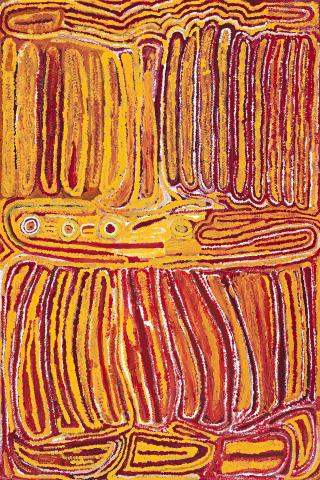CANNING STOCK ROUTE, 1998
15
EUBENA NAMPITJIN
(1920 – 2013)
CANNING STOCK ROUTE, 1998
synthetic polymer paint on linen
180.5 x 120.0 cm
bears inscription verso: size and Warlayirti Artists cat. 487/98
Estimate:
$15,000 – 25,000
Sold for $23,180 (inc. BP) in Auction 48 - 5 April 2017, Sydney
Provenance
Warlayirti Artists, Balgo Hills
The Collection of Colin and Elizabeth Laverty, Sydney, acquired from the above in October 1998
Catalogue text
This work is accompanied by a certificate of authenticity from Warlayirti Artists, Balgo Hills
The Canning Stock Route runs for almost 2,000 kilometres from Halls Creek in the Kimberley to Wiluna in the middle of Western Australia. It is a place where indigenous and non-indigenous histories meet. The track, first surveyed in 1906, was used as a stock route by East Kimberley cattlemen between 1931 and 1959 to move their beef closer to markets in Perth, but long before then, the waterholes, soaks and springs linked as traditional paths for local family groups.
Eubena’s birth country is Kunawarritji, close to Well 33 on the middle stretches of the Canning Stock Route. As a young woman she travelled the length of the route, working cattle with her first husband Gimme and their daughters, before moving to Balgo Mission. This area always carried a profound significance in Eubena’s work, and she continued to depict it throughout her whole life, the only subject she referred to in English as opposed to Kukatja.1
1998 was a pivotal year in Eubena’s artistic career. She had her first solo show at a commercial gallery and was the recipient of the Telstra National Aboriginal and Torres Strait Islander Art Award, Museum and Art Gallery of the Northern Territory (she participated from 1997 to 2003, and again in 2005).
For Eubena, it took years of working in the acrylic medium for her vision to find its fullest expression in a body of work that consistently reveals the spirit essence of country.2 She reached artistic maturity in the middle of the 1990s, when she adopted the brush as painting tool, mixing colours as they were applied, with an increasingly gestural style. It is at this point that the dots joined into lines creating the characteristic petal-like shapes recurring in her works, and her palette developed from muted colours to the vibrant yellows, reds, oranges
and pinks that we associate with her most characteristic work.
1. Carty, J.,’Eubena Nampitjin from Wirrimanu (Balgo)’, in Beyond Sacred: Aboriginal Art: The Collection of Colin and Elizabeth Laverty, edition II, Kleimeyer Industries Pty Ltd, Melbourne, 2011, p. 134
2. Ryan, J., ‘Art’, in Williamson, S. and Togni, S. (ed.), Eubena Nampitjin: art and life, Warlayirti Artists Aboriginal Corporation, Balgo Hills, 2005, p. 19
ELENA SCOTT
